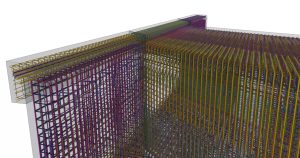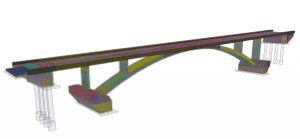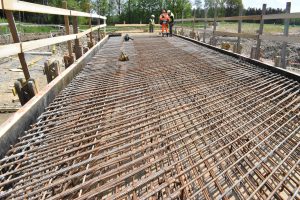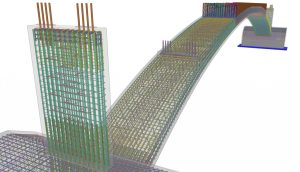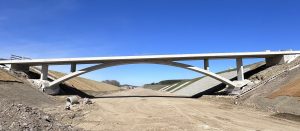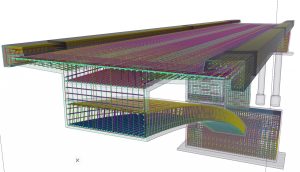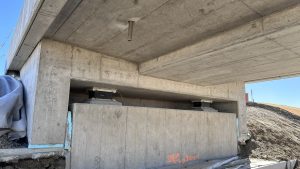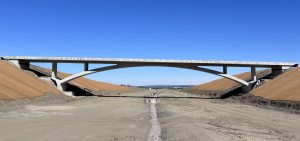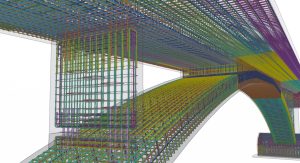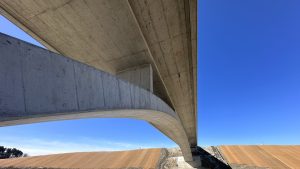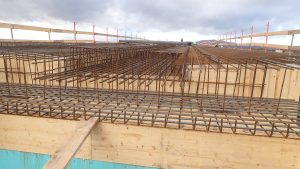 Category winner in these countries:
Category winner in these countries:
Obloukové nadjezdy na stavbě D3 Třebonín – Kaplice nádraží

| Category | Small Scale Projects |
|---|---|
| Year | 2024 |
| Country | Czech Republic |
| Organization | AFRY CZ s.r.o. |
| Author | Martin Neradílek |
| Co-authors | kolektiv AFRY |
| Client | Metrostav Infrastructure a.s. |
| Place of construction | Dolní Třebonín, Česká republika |
| Tags | Parametric designConcreteTekla StructuresTrimble Connect |
Začátkem roku 2022 byla zhotovitelem Metrostav Infrastructure zahájena výstavba úseku dálnice D3 0311 Třebonín – Kaplice nádraží. Tento úsek je předposlední částí budované dálnice mezi Českými Budějovicemi a Rakouskem. Do soutěže je přihlášena trojice mostů budovaných na tomto úseku. Jedná se o rámový dálniční most.
Na 3D modely se můžete podívat v CDE Trimble Connect:
SO 205 – odkaz na 3D model
a o dvojici obloukových nadjezdů:
SO 209 – odkaz na 3D model
SO 212 – odkaz na 3D model
Most SO 205 převádí dálnicí D3 přes vodoteč z rybníka Šindelář. Most je navržen jako uzavřená železobetonová rámová konstrukce. Šikmost mostu je 53,7° a světlost mostního otvoru je 4,0 m. Celková šířka mostu je 34,265 m a minimální výška mostu je 3,4 m. Křídla mostu jsou navržená jako samostatné plošně založené úhlové zdi.
Obloukové nadjezdy převádí pozemní komunikace s volnou šířkou 5,0 m přes trasu dálnice v místě hlubokého zářezu ve skalních a poloskalních horninách. U obou mostů jsou sjednoceny průřezy prvků železobetonové nosné konstrukce. Oblouky jsou navrženy jako dvoukloubové s konstantním obdélníkovým průřezem o rozměrech 700×2400 mm. Vnitřní i vnější stojky mají obdélníkový průřez o rozměrech 400×2000 mm. Vnitřní stojky jsou navrženy jako kyvné a vnější stojky jsou vetknuté do základů a s mostovkou jsou spojeny vrubovým kloubem. Mostovku tvoří železobetonový trám výšky 600 mm s šířkou 2400 mm a vyloženými konzolami s proměnnou tloušťkou 250-350 mm délky 1850 mm.
Celková délka mostu SO 209 je 67,55 m. Rozpětí oblouku je 42 m a vzepětí 5,525 m (L/7,6). Rozpětí jednotlivých polí mostovky je 5,80 m+ 6,40 m + 7,20 m + 15,70 m (spojení s obloukem) + 8,40 m + 8,20 m + 9,30 m. Most je navržen jako zcela integrovaný a opěry jsou založeny na pilotách se zúženým dříkem pro umožnění podélných dilatací.
Celková délka mostu SO 212 je 64,51 m. Rozpětí oblouku je 42,25 m a vzepětí 4,3 m (L/9,8). Rozpětí jednotlivých polí mostovky je 7,50 m + 7,00 m + 7,00 m + 18,41 m (spojení s obloukem) + 6,50 m + 6,50 m + 6,00 m. Ukončení mostu je provedeno jako semiintegrované bez mostních závěrů. Příčník mostovky je tuze spojen s křídly a přes všesměrně posuvná elastomerová ložiska je uložen na plošně založenou železobetonovou opěru.
V tomto projektu byla použita kombinace grafických programů pro vytvoření prostorového modelu včetně jeho vyztužení pomocí propojení programů Rhinoceros, Grasshopper a Tekla Structures. Vyztužení konstrukce je pomocí propojení programů Grasshopper a Tekla parametrické. Současně byla s pomocí programů tvořena klasická 2D výkresová dokumentace.
At the beginning of 2022, Metrostav Infrastructure began construction on the second-to-last segment of the D3 motorway between České Budějovice and Austria – the 0311 Třebonín – Kaplice nádraží section. Three bridges currently under construction within this motorway segment have been submitted for the competition. These include a frame motorway bridge
You can view the 3D models on CDE Trimble Connect:
SO 205 – link to view 3D model
and a pair of arch overpasses:
SO 209 – link to view 3D model
SO 212 – link to view 3D model
The bridge SO 205 transfers the D3 motorway over the watercourse from the Šindelář pond. This bridge has been designed as a closed reinforced concrete frame structure. The bridge is skewed at an angle of 53.7°, with a clearance of 4.0 meters. Its total width spans 34.265 meters, and the minimum height of the bridge reaches 3.4 meters. The wings of the bridge are designed as distinct flat-based angular walls.
The arched overpasses support two roadways with a clear width of 5.0 meters over the motorway where it passes through a deep cut in the bedrock and semi-sedimentary rock. These overpasses feature standardized cross-sections for their reinforced concrete superstructures. The arches are designed as double-joint arches with a constant rectangular cross-section measuring 700×2400 mm. Both the inner and outer piers have a rectangular cross-section of 400×2000 mm. The inner piers are equipped with notched joints on both sides, while the outer piers are firmly connected to the foundations and linked to the bridge deck by notched joints. The bridge deck consists of a 600 mm high reinforced concrete beam, 2400 mm wide, with inlaid cantilevers varying in thickness from 250-350 mm and extending a length of 1850 mm.
The total length of the bridge SO 209 is 67.55 m. The span of the arch is 42 m and the rise is 5.525 m (L/7.6). The span of the individual spans of the bridge deck is 5.80 m + 6.40 m + 7.20 m + 15.70 m (connection with the arch) + 8.40 m + 8.20 m + 9.30 m. The bridge is designed as fully integrated and the abutments are based on piles with a reduced shaft to allow for longitudinal expansion.
The total length of bridge SO 212 is 64.51 m. The span of the arch is 42.25 m and the rise is 4.3 m (L/9.8). The span of the individual spans of the bridge deck is 7.50 m + 7.00 m + 7.00 m + 18.41 m (connection to the arch) + 6.50 m + 6.50 m + 6.00 m. The endings of the bridge are designed as semi-integrated without bridge joints. The bridge deck is rigidly connected to the wings and is supported on a flat-based reinforced concrete abutment via elastomeric bearings.
In this project, a combination of graphic programs was used to create a 3D model, including its reinforcement using the connection of Rhinoceros, Grasshopper and Tekla Structures programs. The reinforcement of the structure is parametric using the connection of Grasshopper and Tekla programs. At the same time, common 2D drawing documentation was created with the help of mentioned programs.
 Category winner in these countries:
Category winner in these countries:


